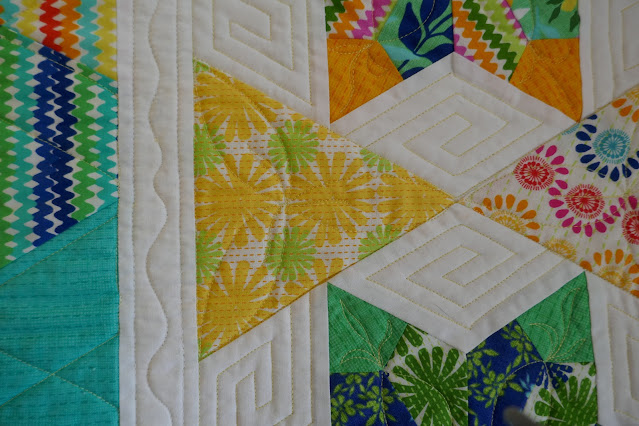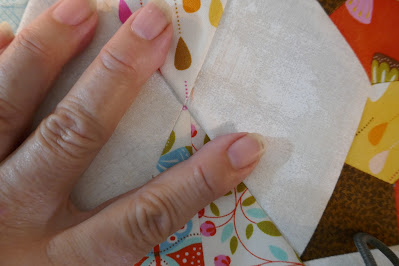Time to share the last steps -- adding borders and some quilting ideas!
I added three borders to my finished top -- first border is the background fabric and cut 2" wide to finish at 1 1/2". Second border used up all my leftovers from the layer cake (plus a couple add-ins because it was pretty tight) -- it's cut 3" wide to finish at 2 1/2". The third border is the background fabric and cut 4" wide to finish at 3 1/2" wide.
.JPG)
The layer cake leftovers could be pieced together with straight seams but for the fun of it, I cut all the pieces on an angle that matched the angles of the star points.
I cut all the leftovers into 3" wide strips (most of them were already that width) and then laid them end to end in a "random" scrappy order -- spacing the colors evenly for a bit of balance. Once satisfied with the order, I stacked up (on the left) and worked down through the stack trimming the ends and restacked them for sewing (on the right).
I used the 60 degree angle on a rotary ruler to trim the ends and
the opposite end was trimmed on the opposite angle.
I used my diamond template to trim the sharp points which helps with the matching as the strips are stitched together.
Lay two pieces end to end as pictured
then when you flip the right sides together for stitching, the alignment will be quick and accurate! You can skip the trimming step but I never do since noticing the increased accuracy of my piecing!
Now just sew all the strips together into one long border band and you are ready to add it to the quilt top.
If you scroll back up to the first picture and look at the lower right corner, you can see that I cut off the band when I reached the corner, squared it up and continued. I added this border "log cabin" style around the quilt to get as many "the color turned the corners" as I could.
Finally, I'm going to share the quilting designs I used on the first version I made of this quilt because I'll probably use the same ones on this version. Why make new choices???
A striped fabric cut on the bias was the perfect binding!!
The outer border was this simple straight line-curvy line repeat worked back and forth -- the straight line was worked stitching forward and the curvy line backwards sneaking along the edge of the second border to get to the beginning of the new line.
For the setting triangles, I marked the center of each piece, then "arced" from point to center, center to point, etc. working around the triangle. It was a big "pumpkin seed" so after the first one, I added the little vein squiggle in the center of each "seed". You can also see the first border quilting -- first I stitched straight lines evenly spaced from the seams, then came back around with the curvy line. The curvy line was freehand -- you can do that!!
This is the best picture I could get of the detail on the star points. My goal is always to do as much continuous stitching as possible to eliminate thread burying. I outlined the center hexagon "in the ditch" and as I got to each blade seam, I arced up to the point, freehand squiggled the point, and then back down to the hexagon. The result was just one beginning and one ending set of threads for each star block.

The background diamonds were quilted as I outlined the blocks. Look at the bottom of the diamond below. Trace the stitching to the left along the seamline. Stop at the first line of the "maze" that you come to and then trace around the "maze". Into the center and back out. Then I stitched a few stitches along the seamline back to the beginning of the "maze", retraced my stitching and on to the next diamond. So again, one starting and one stopping set of threads to bury. The "mazes" aren't perfectly aligned -- I used the edge of my free motion foot to align things and I'm content with the results. If marking makes you happier, use my photo as a pattern for your diamonds.

I have yet to layer my quilt top -- the backing is still to be pieced (but I did find yardage in my stash for that) and I've had to fix a design glitch in my pieced border!?! Scroll back up to the first picture. See those two solid looking brown strips? They were an add-in to bring more brown into the border but when I stepped back (after the borders were finished), they glared at me.
My solution?
I pulled out the tiny scraps I had left of the layer cake
and created a pile of tiny hexagons (1/2"), basting them as for English paper piecing.
I had enough to prep a few 5/8" hexagons and now I'm popping out the papers, pressing the hexagons and machine stitching them in place.
To make it look like it was a "plan" all along (this is a skill you need to cultivate), I scattered some all along the border. It's working -- breaks up the brown globs perfectly but they are a pain in the ---- to stitch down so I keep getting distracted to stitching that is more "fun"!?!
I hope you will give this pattern a try or at the very least, give my Set-In Piecing Simplified technique a try on your next piecing project with set-in seams. They are so much easier than you think they are going to be when you use this technique -- that's my students review of the process!!
If you haven't invested in my teaching guide for the technique, here's a coupon code to use for 25% off until the end of August, 2023! Click on my face up on the right side of the blog and use this code when you check out in my Etsy shop!
Let me know if this series has been helpful and inspiring!
Mary











.JPG)
.JPG)
.JPG)

.JPG)
.JPG)
.JPG)
.JPG)
.JPG)
.JPG)
.JPG)


.JPG)

.JPG)
.JPG)
.JPG)
.JPG)
.JPG)
.JPG)
.JPG)




.JPG)
.JPG)

.JPG)



.JPG)
.JPG)
.JPG)
.JPG)
.JPG)
.JPG)
.JPG)
.JPG)
.JPG)
.JPG)
.JPG)
.JPG)
.JPG)
.JPG)



.JPG)
.JPG)